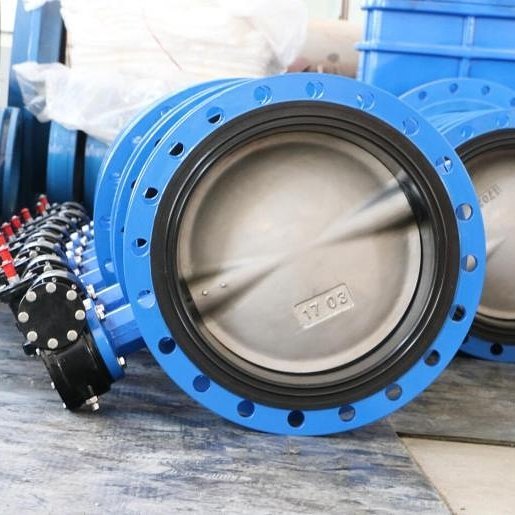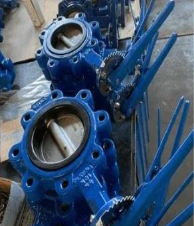Most frequently used flow controlling device in many different industries, butterfly valves are cheap, handy, and easy to design. Butterfly valves, with a turning disc controlling or closing fluid flow, find themselves especially valuable in large diameter pipes where speed, weight, and space are primary considerations.
Our field of specialization at UAE Valves Company is providing a variety of butterfly valves that are capable of fulfilling varied industrial needs. To assist you in choosing the appropriate butterfly valve for your system, we expound on the many varieties, their benefits, and appropriate applications in this article.
Cause of Utilizing Butterfly Valves:
There are various causes as to why butterfly valves are used extensively.
- Small in size
- Light weight
- Quick actuation (90-degree turn)
- Less costly compared to other valves
- Excellent sealing capacity
- Throttling and on/off application capabilities
Some of the sectors using them include water treatment, chemical processing, oil and gas, HVAC, food and beverages, and pharmaceuticals.
Types of Butterfly Valves:
Butterfly valves are categorized on the basis of body type, sealing, and disc position. The most common among them is:
1. Concentric Butterfly Valve (Resilient Seated):
The simplest type of butterfly valve is a concentric one where the seat is of a soft material like rubber or elastomer and the stem goes through the hub of the disc. Low-temperature and low-pressure services employ this valve.
Advantages:
- Economical
- Light to handle
- Suitable for non-corrosive media like water and air
Applications:
- Water supply systems
- HVAC
- Fire prevention systems
2. Double Offset Butterfly Valve (High-Performance):
The disc is situated partly off-centre from the centreline and stem of the valve because of the double offset design. Because the disc quickly separates from the seat when opening, this reduces wear and ensures better sealing.
Advantages:
- Less friction and wear on the seat
- Improved sealing
- Greater temperature and pressure tolerance
Applications:
- Power plants
- Gas and oil
- Chemical processing
3. Triple Offset Butterfly Valve (Metal-Seated):
The conical surface of the sealing surface itself is the third offset in this configuration, on top of the first two. It makes the disc ideal for high-temperature and high-pressure usage by allowing frictionless sealing.
Advantages:
- Zero leakage sealing
- Suitable for critical services and steam
- Increased valve life
Applications:
- Petrochemical plants
- Steam or high-temperature gas pipelines
- Offshore and refinery services
Due to its threaded lugs on the outside of the body, lug type butterfly valves can be bolted between two pipe flanges. They allow downstream pipelines to be supported without the need to remove the entire valve.
Advantages:
- Easy to install and remove it.
- Suitable for end-of-line support.
- Permits two-way flow.
Applications:
- Chemical Industry
- Water distribution
- Piping systems
5. Wafer Type Butterfly Valve:
Wafer-type valves are held in place with long bolts and placed between two flanges. Being capable of stopping backflow in unidirectional flow systems makes this the cheapest variant.
Advantages:
- Light in weight and compact
- Cost-effective
- Easy installation
Applications:
- Water treatment
- Wastewater systems
- Applications that use low pressure
Butterfly valves with flanges on both sides enable pipe ends to be bolted together. They are suitable for high-pressure pipelines and provide strong, secure couplings.
Advantages:
- Reliable sealing
- Simple maintenance
- Ideal for critical systems
Applications:
- Gas and Oil
- Power generation
- High-pressure pipes
7. High- Performance Butterfly Valve:
It provides excellent corrosion, temperature, and pressure resistance through combining features of double or triple offset designs and the latest materials.
Advantages:
- Flexibility in numerous applications
- Longer lifespan and increased efficiency
- Greater control and safe shut-off
Applications:
- Offshore drilling
- Process control systems
- Aggressive media handling
Differences in Butterfly Valve Types:
- Construction and Design:
- Concentric valves consist of a simple design and possess soft seating.
- Double/triple offset valves are durable owing to their metal seats and advanced sealing mechanisms.
- Application Range:
- Low-pressure water applications are best suited by wafer and concentric types.
- High-temperature, high-pressure industrial environments are regulated by triple offset and high-performance types.
- Installation Methods:
- The lug type facilitates isolation through bolt-by-bolt mounting.
- Even though wafer type is more space-saving, removal requires a line stoppage.
- Flanged types are suitable for heavy-duty pipelines and provide firm connections.
- Sealing Mechanism:
- For general services, leak-tight sealing is achieved through soft seated (rubber/elastomer) concentric valves.
- Triple offset valves with metal seats internally provide suitability for corrosive and high-temperature services.
How to Select the Best Butterfly Valve:
The choice of a butterfly valve depends on several factors:
- Temperature and pressure ratings
- Type of media (chemical, slurry, gas, or water)
- Flow control requirements
- Space for installation
- Budgetary constraints
Consider, for example:
- Concentric wafers are best suited for plain water pipes.
- When you are working with chemicals or steam, employ triple offset metal-seated valves.
- Use lug type when pipes need to be isolated without totally shutting down the system.
Butterfly valve effectiveness, flexibility, and economics make it a critical element in fluid control systems today. An understanding of the many forms of butterfly valves facilitates easier selection of the best valve for your individual application to deliver longevity, performance, and safety.
Leading Butterfly valve manufacturer in UAE, UAE Valves offers extensive ranges of butterfly valves suitable for use in different industrial applications in the Middle East as well as the United Arab Emirates. Our experienced team members can guide you through choosing the most appropriate option, no matter whether you require lug/flanged, double offset, triple offset, or concentric type valves.




